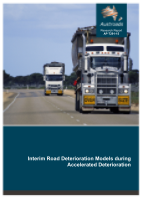Asset Management

- Publication no: AP-T291-15
- ISBN: 978-1-925294-15-6
- Published: 23 March 2015
- PDF (free) Download
The accelerated deterioration of pavements subject to increased axle loading needs the development of interim road deterioration (RD) models so that the cost of accelerated deterioration can be estimated. These RD models were based on selected assemblies of road condition data in the rapid deterioration phase. These data selections produced a wide range of data across a time series to enable the development of the RD models for cracking, and cumulative rutting and roughness. The cumulative rutting and roughness RD models have incorporated an RD model for cumulative cracking due to a lack of surface maintenance. These RD models are expected to be a useful tool for the prediction of the consequences of reduced maintenance on pavement conditions and increased axle mass loading.
- Summary
- Contents
- 1. Introduction
- 2. Aim of this Research
- 2.1. Current Research
- 2.2. Previous Research
- 2.2.1. 2011–12
- 2.2.2. 2012–13
- 3. Assembly of Rapid Deterioration Data
- 3.1. Data from DPTI SA
- 3.1.1. Condition Data Treatment
- 3.2. ALF Data
- 3.3. Data Compilation
- 4. Data Analysis
- 4.1. Rutting RD Model
- 4.2. Cracking RD Model
- 4.3. Roughness RD Model
- 4.4. Other RD Models
- 5. RD Model Testing
- 5.1. RD Model Test Approach
- 5.1.1. RD Rutting Model
- 5.1.2. RD Cracking Model
- 5.1.3. RD Roughness Model
- 6. Conclusions and Proposed Further Work
- 6.1. Scope of Work
- 6.2. Conclusions and Outcomes
- 6.3. Further Work
- References
- Appendix A Model Parameter Definition
- A.1 Summary
- Appendix B Conversion of ALF Results
- B.1 ALF Experimental Results
- B.2 Equivalent Pavement Age, AGE
- B.2.1 Equivalent Traffic Load, L
- Appendix C Use of ALF Results
- C.1 Loss of Surface Area Models
